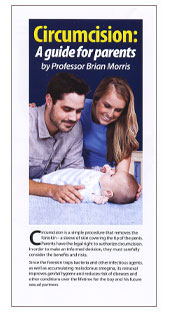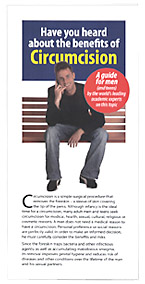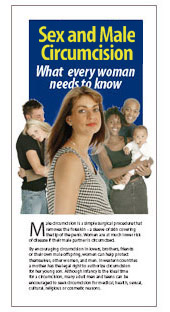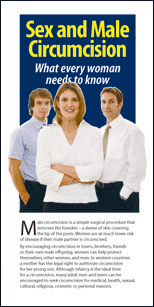Circumcision - Position Statements by
National Medical Bodies
In 1971 the American Academy of Paediatrics (AAP) Committee for the Newborn came out with a statement that said there are "no valid medical indications for circumcision" [Committee., 1971], although this statement had only a slight effect on the rate of newborn circumcision in the USA.
In 1975 the statement was modified to "no absolute valid ..." [Thompson et al., 1975], which remained in the 1983 statement, but in 1989 it changed significantly to "New evidence has suggested possible medical benefits" [American, 1989]. In his 2008 book, the Chair of the 1989 committee, Dr Edgar Schoen, recounts his experiences on this committee [Schoen, 2008]. He describes the 1975 Statement as “safe, but misleading and a misrepresentation of the facts”, saying “The 1975 Task Force Chair, Dr. Thompson was upset by this sleight-of-hand word change [of substituting the word “absolute” (in the 1975 statement) for the word “valid” (in the 1971 Statement)] by the neonatology group and in 1983 when the 1975 “no absolute medical indiction” statement was reiterated by both the AAP and the ACOG, he expressed his frustration in an editorial in the American Journal of Diseases of Childhood, but there was not much he could do by then”.
However, in its 1999 Statement [Lannon et al., 1999] the AAP went backwards. Although the literature review it conducted was academically weak, it did, nevertheless, mention the vast array of benefits. The major flaw of this document was that it fell short of stating the obvious, if it had used a more balanced literature survey, in recommending circumcision. This may have been quite understandable, given medico-legal worries in the face of very hostile, politically active anti-circumcision groups.
In a joint response the Chair of the 1989 AAP Taskforce on Circumcision, Edgar Schoen, and others more expert than those on the 1999 Taskforce, rebutted the 1999 statement [Schoen et al., 2000c; Schoen et al., 2001]. Others also leveled valid criticisms [Bailis, 2000; Kunin, 2000].
Surprisingly, in 2005 the AAP reaffirmed its 1999 policy [American, 2005b], in effect suppressing all of the very strong affirmative evidence published since its 1999 statement. Schoen strongly condemned the AAP for ignoring the 7 years of extensive research findings since 1998 [Schoen, 2006a]. Further to this, in 2007, when challenged by Schoen [Schoen, 2007b], a Section Editor of the top journal in the field, Pediatrics, called for the AAP to reassess its position in the light of new data [Elder, 2007a].
The various statements by such real experts highlight the information that follows in the present much more comprehensive and better-balanced internet review.
It is clear that providing a scientifically accurate Statement by a pediatric body is difficult in the face of minority lobby groups whose agenda tends to be a political one rather than medical or scientific. This is not to detract from the clear scientific weaknesses in the 1999 AAP Statement and their pamphlet [Bailis, 2000; Schoen et al., 2000c].
Dr Edgar Schoen stated that the benefits of routine circumcision of newborns as a preventative health measure far exceed the risks of the procedure [Schoen, 1993]. He has continued to this day to campaign for public education of the benefits of circumcision, publishing a very worthy book on the topic in 2005 [Schoen, 2005b] and another in 2009 [Schoen, 2008].
In 2012 the AAP after an extensive review of all the medical evidence released a new policy recommending infant circumcision [American Academy of Pediatrics 2012a,b]. The AAP Task Force found that benefits exceed risks and recommended accurate nonbiased education of parents before conception or early in a pregnancy, the development of educational material, provider training, effective pain management, sterile technique, and third party (insurance) coverage. It nevertheless recognized that for some families cultural or personal preferences might affect an informed decision. The American College of Obstetricians and Gynecologists endorsed the 2012 AAP policy.
The Centers for Disease Control and Prevention (CDC) released draft recommendations for public comment in 2014 [Centers 2014a,b]. In 2018 its final peer-reviewed document appeared [Centers 2018a]. It cited additional publications, including a study in Mayo Clinic Proceedings that found benefits exceed risks by “100:1” [Morris et al., 2014a]. As well, the CDC provided a detailed repudiation of criticisms it received from circumcision opponents [Centers, 2018b].
During the period 1985-92 there was an increase in the frequency of post-newborn circumcision (to over 80% in one study [Wiswell & Hachey, 1993]) and during that same time Schoen points out that the association of lack of circumcision and urinary tract infection (UTI) has moved from "suggestive" to "conclusive" [Schoen, 1993]. Moreover, this period heralded the finding of associations with other infectious agents, including HIV. In fact he goes on to say that "Current newborn circumcision may be considered a preventative health measure analogous to immunization in that side effects and complications are immediate and usually minor, but benefits accrue for a lifetime" [Schoen, 1993].
Through the 1990s and into the new millenium the rate of circumcision has continued to rise. In the light of an increasing volume of medical scientific evidence pointing to the benefits of neonatal circumcision, the pediatric professional bodies of various countries have been forced to review the evidence and formulate more up-to-date policy statements. These documents MUST be read in their ENTIRETY to be fully comprehended. (Isolated quotes have been taken from these by anti-circumcision groups to fuel their propaganda.)
What is stated in the details of the various Statements is much like what is presented in the present review of the medical literature. However, it is important to note that vital facts have been distorted, watered down or omitted from the various Statements of pediatric bodies, whereas the present review is very much more comprehensive and balanced. Moreover, no medical body has advocated prohibition of circumcision and arguments by opponents are weak and specious [Viens, 2004].
Older statements of the American Academy of Pediatrics in 1999 [Lannon et al., 1999], the Canadian Paediatric Society in 1996 [Fetus, 1996] and the Royal Australasian College of Physicians, Division of Paediatrics and Child Health in 2004 [Beasley et al., 2004] provide information on the benefits and possibility of rare or minor risks. These suffer, however, from falling short of drawing the obvious conclusion from the evidence they present, i.e., that circumcision is the best choice for lifetime health and sexual well-being.
The hesitancy is undoubtedly a consequence of the sensitivity of this issue, as well as medico-legal caution and the recognition of the hysteria that this subject can provoke because of the diversity of opinion in the community, where anti-circumcision groups tend to bombard such professional bodies in an attempt to "win" their "political" cause. More on this can be found in the section "Anti-circumcision lobby groups".
The British Medical Association has not even attempted to review the medical literature, producing instead a pompous paternalistic and legalistic statement in 2003 [British, 2003; British, 2004]. In 2006 it produced a document that recognized the "spectrum of views within BMA's membership", stating that the "BMA has no policy", and "the BMA believes that parents should be entitled to make choices about how best to promote their children's interests subject to limitations imposed by society" [British, 2006].
In 2007, however, the British Medical Journal (the official journal of the BMA) published two short 'head-to-head' opposing commentaries, one consisting typical anti-circ emotive, legalistic nonsense that was opposed to circumcision [Hinchley, 2007], and the other, by an Editorial staffer, that was a quite sensible, balanced overview of the many benefits and why "it is far better to help parents to find a competent operator" than make it difficult for them as the BMA guidelines advise [Patrick, 2007]. These were followed by an article on medical indications for circumcision, which distorted and downplayed the benefits by selectively citing publications that supported the authors' negative agenda [Malone & Steinbrecher, 2007]. It was nevertheless a good sign that at long last the BMA via the BMJ had begun to address the issues.
In 2019 a new “guidance” was released by the BMA [British, 2019]. Once again, the BMA did not conduct a scholarly review of the medical literature, which its constituents might rightly expect as a mandatory prerequisite to the formulation of guidance on any medical issue. The BMA’s statement is thus disappointing, to say the least.
By and large, the statements of most of these professional bodies tend to recommend that medical practitioners fully inform parents of the benefits and minor, rare risks of having their male children circumcised. Thus publicly most give the impression that the benefits and harms are very evenly balanced [Fetus, 1996]. Indeed, professional bodies have carefully avoided taking sides in the polarized debate, by making noncommittal guidelines and leaving it to the medical practitioner to discuss the matter with the parents [Franco, 2004].
While such bland tolerance has accommodated a broad range of strong and conflicting opinions, the medical profession is now faced with a growing knowledge-base that indicates a wide range of health benefits of circumcision and that these exceed any risks, meaning that the time is fast approaching when affirmative statements cannot be avoided [Franco, 2004]. Indeed, Prof Roger Short states “If we believe in evidence-based medicine, then there can be no debate about male circumcision; it has become a desirable option for the whole world” [Short, 2004b].
Of course, well-informed medical practitioners only have to read the present Statements of pediatric bodies in full to be able to draw their own conclusion.
In a deplorable ploy, the Royal Australasian College of Physicians' (RACP) 2002 and 2004 Policy Statement sidestepped making a conclusion by instead substituting the words there "is no medical indication for routine infant male circumcision', i.e., that the foreskin as it presents at birth lacks any medical condition that would mandate its removal. This tactic is to be condemned as inexcusably irresponsible, especially in the current era of preventative medicine and medical knowledge of the benefits of circumcision. Indeed the RACP's 2004 Policy lacks scholarship and is not evidence-based.
The 2004 RACP Policy statement was resoundingly criticized in a large peer-reviewed journal article by the author of the present review and other international experts [Morris et al., 2006a]. The abstract of this critique appears below, and to download the full article simply click here.
The CEO of the RACP subsequently phoned the present author and acknowledged the flaws in its 2004 policy statement. The RACP then formed a new committee to revise its policy, and in so doing made an attempt to no longer base the RACP statement on the views of 'selected' pediatricians, but to involve a public health expertise as well. The present author conducted a detailed peer-review of a draft of the new policy statement in late 2008, and of a revised version in mid-2009. It was clear that the committee of non-experts were struggling to develop an evidence-based policy.
A new policy appeared in 2010 on the RACP's website. While this was better than the 2004 policy it was still not evidence based, but rather an opinion piece by the chair of the committee and significant other members of the committee opposed it. A devastating critique of that policy was published in an official journal of the RACP by five prominent Fellows of the RACP and Fellows of other Colleges and medical organizations [Morris et al., 2012c]. (See home page.)
The only evidence-based infant male circumcision policy in Australia is that produced by the Circumcision Academy (formerly “Foundation”) of Australia in 2012 (see home page). This was formulated by many of the same Fellows as above as well as other public health experts and was published in a peer-reviewed journal. Unlike like the RACP policy it included a risk-benefit analysis. In 2017, Fellows of the RACP and other medical bodies published an extensive systematic review, risk-benefit analysis and evaluation of progress in policy tailored to Australia and New Zealand [Morris et al., 2017e]. This should form the basis of needed policy evidence-based policy development by the RACP. In 2017, Fellows of the RACP and other medical bodies published an extensive systematic review, risk-benefit analysis and evaluation of progress in policy tailored to Australia and New Zealand [Morris et al., 2017e]. This should form the basis of needed policy evidence-based policy development by the RACP.
The American Urological Association has produced a statement on circumcision that, albeit brief, is very much in keeping with the medical evidence of the wide-ranging benefits of circumcision. This was updated in 2007 to include the latest evidence on protection from HIV/AIDS [American, 2007a]. It was further updated in 2017 and reaffirmed in 2018 [American Urological Association, 2018]. It states "the American Urological Association recommends that circumcision should be presented as an option for health benefits".
On 28 March 2007 the World Health Organization and UNAIDS endorsed circumcision for HIV/AIDS prevention [WHO, 2007]. Later in 2007 a further statement was produced that listed the vast array of benefits as well as issues concerning the ‘roll-out’ of circumcision, particularly to places and people at high risk of HIV infection [World, 2008b]. This noted that most cultures that do not circumcise are neutral on this issue and would readily embrace it when the benefits are explained.
In the light of these facts and other mounting evidence of the benefits many are now calling for endorsement of routine circumcision by pediatric bodies. To quote one 9 author commentary in Pediatrics: "Therefore, if parents choose circumcision for their newborn male child, or if an adolescent decides that circumcision might be appropriate to reduce risk of STD acquisition, it is a medically rational choice that should be included in government health or private insurance benefits" [Flynn et al., 2007].
In 2006 Edgar Schoen, Chairman of the 1989 AAP Task Force on Circumcision stated "It is time for the AAP to acknowledge the evidence and to catch up to the American public' [Schoen, 2006a]". The AAP has now done this with its 2012 policy.
Prior to the 2012 AAP policy, another author, in Pediatrics, concluded "I firmly believe that there is now sufficient new information to prompt a revised AAP policy statement regarding neonatal circumcision, considering the very significant beneficial effects and the very minor risks associated with this procedure" [Dickerman, 2007]. Other US experts stated in 2007 "Given recent studies suggesting the public health benefits of male circumcision, a reconsideration of national male circumcision policy is needed to respond to current trends" [Mor et al., 2007]. Dr Susan Blank, chair of the 2008-2010 AAP Task Force on Circumcision said on ABC News that the Academy noticed some "really very compelling data" and that "it was time to look at the full body of literature and see what is out there". Recognized authoritative figures in the USA in particular strongly advocate circumcision of all newborn boys. More details of what they have said in the medical literature appear later. The New York Times (Aug 24, 2009) quoted Dr Michael Brady, a consultant for the AAP, as saying "The academy is revising its guidelines and is likely to do away with the neutral tone in favor of a more encouraging policy stating that circumcision has health benefits even beyond HIV prevention, like reducing urinary tract infections for baby boys" [Rabin, 2009]. And that is exactly what it has now done with its 2012 policy.
The main story in this article was that the Centers for Disease Control and Prevention (CDC) indicated in very strong terms that it wanted to promote routine infant male circumcision for disease prevention. The author of the present review was asked to comment. To see a video of the TV interview go to: http://au.lifestyle.yahoo.com/b/sunrise/31148/circumcision-the-case-for-and-against. The CDC has now come out with an affirmative policy.
In Jan 2010, the outcome of a 2 day consultation held in April 2007 with a broad spectrum of stakeholders, was published in Public Health Reports [Smith et al., 2010]. This stated "Consultants suggested that (1) sufficient evidence exists to propose that heterosexually active males be informed about the significant but partial efficacy of MC in reducing risk for HIV acquisition and be provided with affordable access to voluntary, high-quality surgical and risk-reduction counseling services; (2) information about the potential health benefits and risks of MC should be presented to parents considering infant circumcision, and financial barriers to accessing MC should be removed".
Also in Jan 2010 an objective review by experts at John's Hopkins University and the National Institutes of Health highlighted the long-standing benefits and provided an update on newer data concerning STIs [Tobian et al., 2010]. The article argued the case for neonatal circumcision and concluded that "with mounting evidence that male circumcision decreases viral STIs, genital ulcer disease, and penile inflammatory disorders in men, and bacterial vaginosis, T. vaginalis infection, and genital ulcer disease in their female partners, it is time for the AAP policy to fully reflect these current data". This was supported by an editorial commentary in the same issue [Brady, 2010]. The journal also published a brochure for parents that listed health benefits and stated that risks of the procedure were minor [Moreno et al., 2010].
The Canadian Paediatric Society (CPS) released a policy in 2015 [Sorokan et al., 2015]. However, owing to a seriously flawed risk-benefit analysis (which was then performed correctly by critics [Morris et al., 2016a]) it only recommended newborrn circumcision for boys in high risk situations. The critics recommended that the CPS revise and correct its policy, but this advice has been ignored. Instead, the CPS attempted to refute the criticisms [Robinson et al., 2017], but its response was shown to contain fundamental errors in knowledge and to be seriously flawed [Morris et al., 2017a]. Since the 2015 policy is not evidence-based it cannot be relied on.
Table. Articles opposing circumcision (left column) and critiques of each publication (right column)
Topic
| Anti-circumcision | Critique(s) of each respective article |
| 2012 AAP infant circumcision policy | |
| Frisch et al. 2013 | AAP Task Force 2013 |
| Svoboda & Van Howe 2013 | Morris et al. 2014c |
| Jenkins 2014 | Morris et al. 2014d |
| Darby 2014 | Morris 2014 |
| Darby 2015 | Morris et al. 2016 |
| Jansen 2016 | Morris et al. 2014d |
| Svoboda et al. 2016 | Brady 2016, Morris et al. 2017b |
| 2014 CDC circumcision draft policy | |
| Earp 2015 | Morris 2015 |
| Adler 2016 | Rivin et al. 2016 |
| Frisch & Earp 2018 | Morris et al. 2017c |
| Centers 2018b | |
| 2010 RACP policy on infant circumcision | |
| Royal Australasian 2010 | Morris et al. 2012d |
| Forbes 2012 | Morris et al. 2012g |
| 2015 CPS policy on newborn circumcision | |
| Sorokan et al. 2015 | Morris et al. 2016a |
| Robinson et al. 2017 | Morris et al. 2017a |



